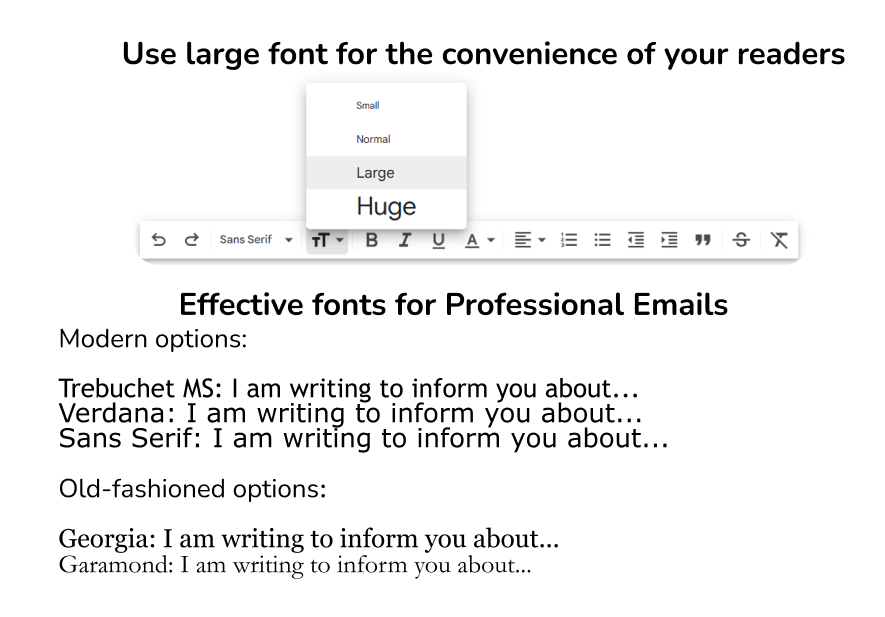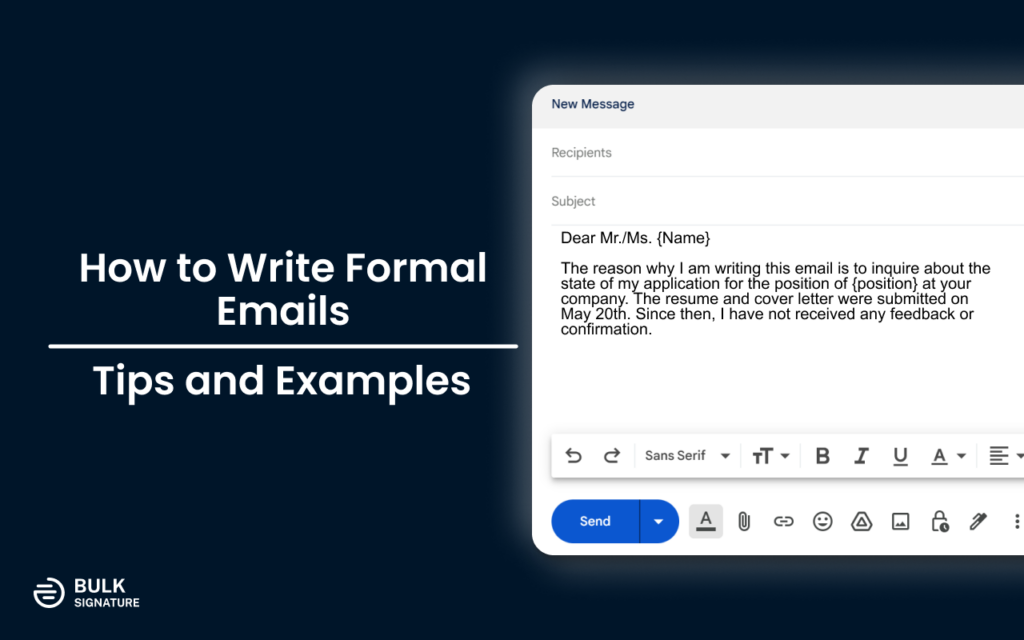
Formal emails have become a huge part of our life. Almost every working routine starts with emails, we reply to clients, check our tasks, write announcements to our team, request information from colleagues or employees, follow-up with our network, and much more.
We know that an average person sends and receives approximately 120 emails a day. On top of that, the number of email users worldwide is steadily growing. We know that at the end of 2023, the number of email users will reach 4.4 billion. Here is why we need to understand how to properly enable this mean of communication.
Even if you are an experienced specialist, you might’ve found yourself in the situations when you need to compose an effective email for different purposes. In this article, you’ll find out how to write formal emails the best way possible.
Contents
Formal email's structure: What your email should have
So, what is the formal email format? The structure of your email depends on the recipient you are writing to. Your relationship with the recipients helps you identify the level of formality. Keep in mind, in most cases the safest way is to go with the formal version. Here is what a structure for a formal email should look like:
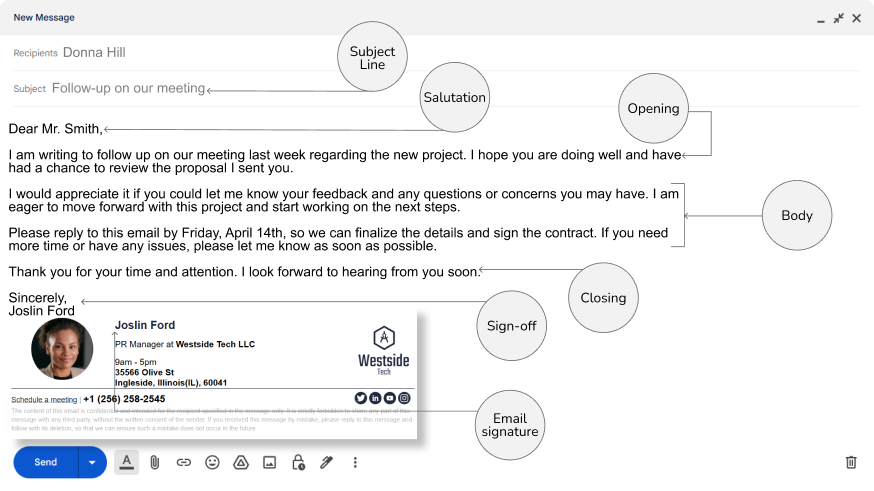
Formal emails seem to be complicated and simple at the same time. The simplicity is about their strict structure. Here is the structure on the following key elements of your email.
Email subject
The most significant part of your email is the first thing that your recipients see — a subject line. It must be convincing, relevant, and safe. Putting yourself in the shoes of a recipient can help you to decide if your subject line is good enough. You might ask yourself a question: Would I open an email with a similar subject?
In the majority of cases, it is better to come up with a subject line after composing your email’s body. This approach will allow you to have a better idea of your email’s content, thus helping you to make an efficient subject line.
Keep in mind, the purpose of the subject line is to give your recipients a better idea of why they should open your email.
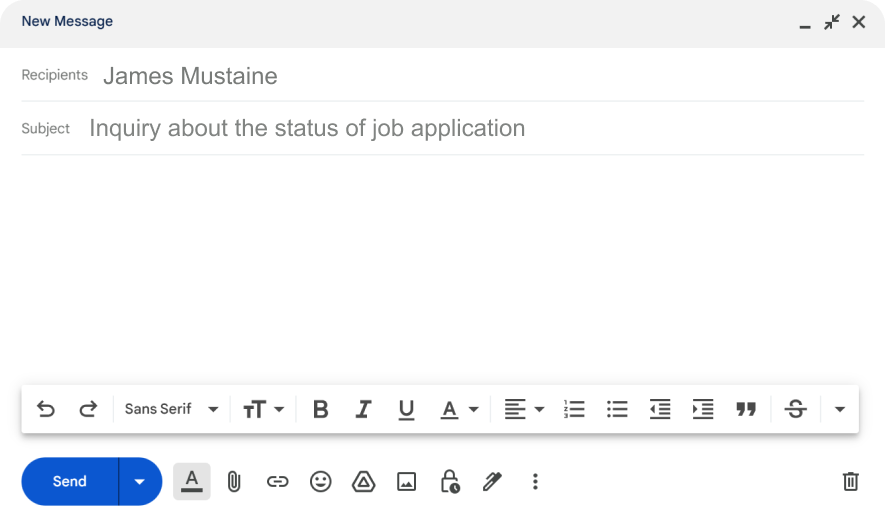
Here is what email subjects in formal emails may look like:
Complaint regarding the quality of displays
Annual leave request — March, 10-17
Introducing our new PR Manager
Thank you for your performance!
Email salutation
Starting your formal email is not much of a deal. However, you have to keep in mind that depending on the level of formality between you and a recipient, your salutations can range from common “Dear Ms/Mr/Professor/Sir or Madam/Sirs or Madams…” to “Hi, Hello…” and a basic “Greetings”
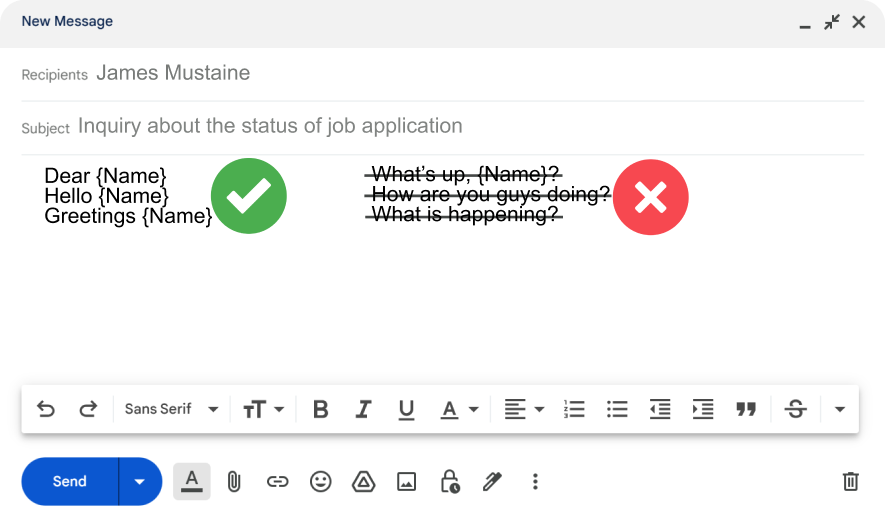
Below, you can see what formal email salutations can be used in formal communication:
Hey there,
Hi, {Name}
Dear {Name}
Dear Mr/Ms/Professor/Dr {LastName}/Sirs or Madams/Sir or Madam/Representatives of …
Greetings
Opening lines
An opening line is another significant checkpoint for your potential recipient. At this stage, you should catch the recipient’s attention. Here’s why you have to give the reasons to your recipients why they should continue reading your email.
Here is what you should keep in mind when you make your email opening line:
Make your opening lines reflect your subject. It is quite common for average recipients to subconsciously evaluate the relevance of emails they receive. Make sure you base your subject line on opening lines or the other way around.
State personal experience. Try connecting your email to the background of your recipient. You might achieve this by expressing appreciation of their works or any public information about them.
Be clear and straightforward. Let your readers know why you are reaching out to them. It is also crucial to remain polite and clear.

Depending on the situation, your opening lines may be different. Here are some of the examples what an email opening line may look like:
First-time email: My name is … and I am writing in connection with …; My name is … and I am contacting you to/about…;
Follow-up: I just wanted to follow up about …; The reason why I am writing is to follow up about…;
Request: I am writing in connection with; I was hoping it might be …; I would like to know if you are able to…;
Compliments: Incredible work on …; I would like to express gratitude for…; Congratulations on an accomplishment with …;
Checking in: I would like to know if you could share the progress of…; I am writing to find out if it is it possible to get any information on the progress of…
Email body
It is certain that the core part of your email is the main body. Thus, the main goal lies in persuading the reader to get the necessary information from it. On top of that, you do not want your recipients to miss any significant points. Here are some tips that you can follow to understand how to write a formal email body:
Ensure your email focuses on one topic. If your email touches upon several unrelated topics, it’s better to take time to write several separate emails. This way, you can increase the time that it will take to process your email.
Give reasons when you request something from the recipient. Make sure you explain why you want your readers to do something. It is obvious that our brain gets more convinced when it receives the reasons for doing something.
Use short paragraphs to improve the readability of your emails. When the content is split into smaller sections, it is much easier to perceive information. In some cases, it might be efficient to write a straight to the point sentence per paragraph.
Take advantage of text styling. If there is a primary question or request in your email, don’t hesitate to write it in bold or italics. Don’t forget to highlight the information you want to be emphasized to your readers. But be careful, everything is good in moderation, try not to overdo it with styling.
Closing lines
On the one hand, closing lines have a good number of ways to be written that drastically depend on the goal of your email. If your email has a specific request, you can end your email by enlisting the set of actions that needs to be done.
On the other hand, if your email does not pursue any specific requests, you can finish it up simply by expressing respect to your reader. Mentioning your willingness to support them with any information on request can also be considered as a positive gesture.
Here is how a closing line should look like in a formal email:
Thank you very much for reaching out.
Don’t hesitate to reach out to me if you have any questions.
I appreciate your feedback a lot. Let’s remain in contact.
Please inform me if you need anything else to complete this task.
Email sign-off and signature
Various sign-offs have different levels of formality. Here’s why you should be careful with which ones to use depending on the situation. However, finding the best sign-off is always a struggle. Just make sure your sign-off fits perfectly your email writing and your recipient. Here are what email sign-offs you can use in your formal emails:
Sincerely
Best regards
Kindest regards
Yours truly
Respectfully
Thanks again
There is a huge range of other casual email sign-offs that you can use in your email writing. Here’s what you can use instead of dull Best regards in every single email:
Take care
Have a great day/week/weekend
Catch up soon
Hope you’re having a great one!
Much appreciated!
Wishing You a Wonderful Day
Hope you’re making it through!
Pleasure catching up with you
Congrats on reading this whole email
One step closer to Friday
As you probably noticed all of the best regards synonyms have different level of formality. Make sure you use the right option in your communication to avoid misunderstanding.
Conversely, email writing is becoming more and more flexible. As a result, we end up bringing the vocabulary outside the formal business communication. One such example that is getting extremely popular is ‘V/R’ at the end of emails. ‘V/R’ is a term that is used in military, which today is getting a lot of love from business specialists. If you’ve been wondering what it means, it basically stands for ‘very respectfully’. Is it okay to use in formal email writing in 2024? Well, in today’s world everything is possible. The business communication is dramatically moving away from formality and all the means that haven’t been there turn into trends in the matter of moments.
Apart from your sign-off, there is another major point that you should review before sending emails — your email signature. And this is a completely different story. In order to properly create a professional email signature, you need to follow a set of steps that depend on your needs. What you need to know, however, is that you should not underestimate the value of email signatures, since they are considered to be a part of your brand. They reflect the image of your company and build your overall professionalism. On top of that, they allow you to share your contact information. The best part is that you can neatly present your social media channels using icons. BulkSignature is an email signature management solution for Google Workspace that allows you to create and manage professional email signatures.
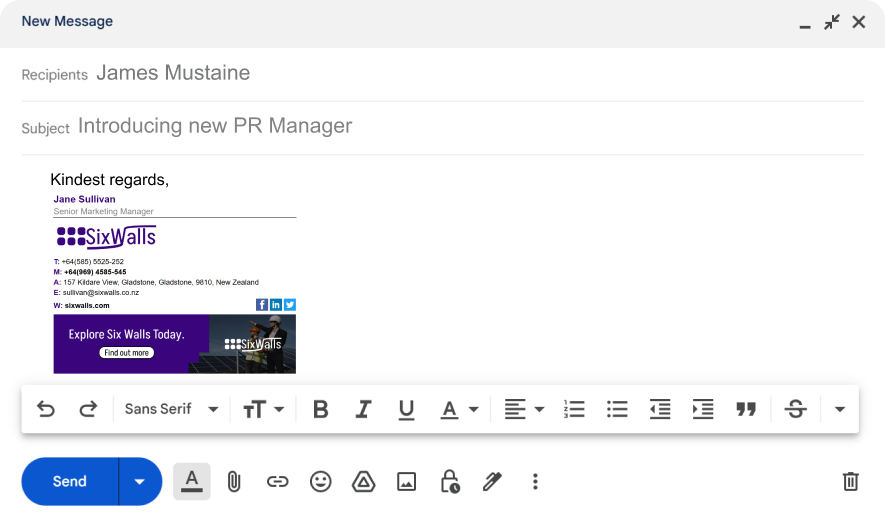
Formal emails style and rules
It is obvious that formal written style is always associated with long sentences and complicated structures. However, when it comes to formal email writing it is a bit of a misconception, since business communication primarily relies on concise sentences and clear structures. Therefore, splitting up paragraphs can significantly improve your emails’ readability and allow your recipients to quickly see the key points.
Font Style and Size
When it comes to the font style/size of your formal email text, there are different trends happening in the world of business communication. The most important thing is to use large font, which provides perfect readability and is much more efficient for mobile devices. On top of that, we are aware that more than 46% of all emails are opened on a mobile device. Here’s why it is always good to go with the large size of the font.
At the same time, going with classical serif fonts such as Georgia, Garamond, Serif, etc. may seem a bit old-fashioned. Thus, it is better to employ such modern options as Trebuchet MS, Verdana, Sans Serif. These basic options will help you make your email writing significantly better.
Formal email etiquette
Most importantly, while making a formal email, you shouldn’t neglect the aspect of courtesy. Depending on the recipient, it is always better to be polite in terms of the requests and use appropriate forms. Even though in some cases, this kind of form may seem excessive, it is still a safe bet.
Here is how to politely ask questions in formal emails:
Do you think it would be possible if…
I would like to know if you can…
It would be much appreciated if you could possibly…
Email Etiquette Across Cultures
Understanding email writing etiquette across cultures helps avoid misunderstandings, ensuring your message is interpreted as intended. It demonstrates respect and professionalism, fostering stronger relationships with international colleagues or clients. Ultimately, it leads to more effective communication, enhancing your reputation and the success of your interactions. The core factors to keep in mind in your formal email are Cultural differences, Formality and Tone, Time Expectations.
Cultural Differences. Different cultures have unique norms. For instance, while Americans often get straight to the point in emails, Japanese professionals might start with polite greetings and small talk.
Formality and Tone. The tone varies across cultures. Germans typically use formal salutations in business emails, while Australians might opt for a more casual tone. Also, humor or sarcasm may not translate well across cultures. For example, British sarcasm might be misunderstood by American colleagues.
Time Expectations. Response time expectations differ. In the U.S., immediate responses are common, but in countries like Brazil, a delay might be acceptable.
Formal email examples
Now, let’s have a look at some of the formal email examples that you can use to write professional emails in your own communication:
Email in Response to a Job Posting
Ever wonder what you should write in an email when you send a resume? Here is what a formal email for sending a resume in response to a job posting may look like:
Subject: Application for {Job Title} – {Your Name}
Dear {Hiring Manager name},
I am writing to express my interest in the [Job Title] position that I saw advertised on [Platform where you saw the job posting].
I have {Number} years of experience in {Your industry} with a strong background in {Skills relevant to the job}. In my previous role at {Previous company}, I {Briefly mention a relevant accomplishment that showcases your skills}.
My skills and experience closely align with the qualifications outlined in the job description, particularly {Mention specific skills from the job description that you possess}. I am confident that I can make a significant contribution to your team.
I have attached my resume for your review. Likewise, I am eager to learn more about this opportunity and how I can contribute to {Company Name}’s success. Thank you for your time and consideration.
Sincerely,
{Your Name}
{Phone Number}
{Email Address}
Follow-up email
Sometimes it’s quite problematic to find the right words when you need to follow up in email writing. Below, you can find what a professional email may look like. The example can be considered as the most common email template that can help you meet your needs.
Subject: Re: {your previous email subject line}
Dear Mr./Ms. {Name}, / Hi {Name}, / Hello {Name},
The reason I am writing is to follow up about {offer/arrangement/collaboration/etc.}
I am highly interested in {highlighting key points of arrangement/offer/collaboration/etc.}
I believe my {skills/knowledge/experience/etc.} will be relevant to you and I will be able to exceed your expectations.
I would highly appreciate it if you could keep me updated on your decision.
Let me know if you need any additional information about me or my projects!
Best regards,
{Your name}
{Job title}
or
{Email signature}
Request email
Another common email matter is often related to requests of different kind. The flexible email template below will allow you to perform the request of any kind. Below you can find what a formal email request should look like:
Subject: Request of {reason}, {Date} / {Reason} request
Dear Ms./Mr. {Name},
The purpose of the present email is connected with the {request} about {matter}. I am interested in {the reason of your request execution}.
I would kindly like to ask if it is possible to {additional information about the request}.
{Additional information that is required for the execution of the request}
Let me know if I need to provide additional information.
Your prompt response and cooperation would be highly appreciated.
Kindest regards,
{Your name}
{Job title}
or
{Email signature}
Email for Inquiry about Job Application Status
During your job search, staying informed about your applications is the key. The best way to achieve this is by following up with a well-crafted letter of inquiry. This follow-up demonstrates your continued interest in the position and keeps your application fresh in the hiring manager’s mind. Here is what an email for inquiry about job application status should be:
Subject: Inquiry about the status of job application
Dear Ms./Ms. {Name}
The reason why I am writing this email is to inquire about the state of my application for the position of {Position} at your company. The resume and cover letter were submitted on May 20th. Since then, I have not received any feedback or confirmation.
I have a great interest in working for your company. Moreover, I believe I possess all the necessary skills and knowledge that meet your requirements. I have over {years} of experience. On top of that, implementing {list of responsibilities}. I also have {education/certificates}.
I would highly appreciate it if you could update me on the progress of my application.
Feel free to reach out to me for additional information. I will be glad to provide everything you need.
Thank you very much for your consideration.
I am looking forward to your reply.
Sincerely,
{Your name}
{Job title}
or
{Email signature}
Customer support email
Email’s asynchronous nature, detailed format, and record-keeping make it ideal for customer support. But sometimes in order to get the desired result you need to deliver fast, professional, and consistent communication to your customers. Here is how to write a formal customer support email:
Hey {Name},
Thank you very much for reaching out to us. We appreciate your feedback, and we are sorry to hear that you experienced issues with our product.
I would like to know if you could provide us the following information for better assistance:
{Point 1}
{Point 2}
{Point 3}
For now, you can try this: {Immediate/temporary solution}
Looking forward to your reply! Once we receive the requested information, we will be able to proceed by resolving your problem.
Have a good day!
Sincerely,
Customer Support Team
Complaint email
Writing a complaint email allows you to clearly document an issue, seek resolution, and potentially improve the service or product for yourself and others. It gives the company a chance to address your concerns and shows you’re invested in a positive outcome. Here is how to make a formal complaint email:
Subject: {Order number}, Complaint about {product}
Dear Customer Support Team
I am writing to inform you about my dissatisfaction with the product, which I purchased from {online store/physical store} on {date}. The product was {brief description of the product}.
I received the product on {date}. I soon found out the product was defective. {The explanation of the defect}.
I am disappointed with the quality of the product. I would like to request a full refund of {price of the product}.
Let me know if I need to provide any additional information.
I hope you will take this matter seriously and resolve it as soon as possible. Otherwise, I will have to take further action.
Sincerely,
{Your name}
{Your phone number}
Formal response to a complaint
A formal response to a complaint shows respect for the customer, demonstrates professionalism, and creates a clear record of how the issue is being addressed. The business email writing example below will help you to direct your composing process. Here is how to professionally compose a formal response to a complaint:
Subject:
Dear {Name},
I am awfully sorry to hear that you are not satisfied with the product. We appreciate your feedback, and we truly want to resolve your issue.
Your purchase has been refunded, and you should receive it back very shortly.
Please let us know what went wrong with your {product/service/application/etc.} and how we can make it up to you. You can reach out to us by phone or email any time.
We sincerely apologize for the inconvenience you experienced.
We hope to hear from you soon.
Kindest regards,
{Your name}
{Job title}
or
{Email signature}
{Your phone number}
Work Update Email
Work update email build trust and collaboration. Regular updates demonstrate transparency and accountability, which strengthens trust and improves a collaborative work environment. Understanding the progress is the best way to keep everyone in the loop. Here is what a professional work update email may look like:
Subject: Work update for {date}
Hello team,
I hope you are having a good spring and enjoying the weather. In this email, I would like to share with you some updates on our ongoing projects and tasks for the week.
Project 1: We have completed {A, B, C, …} and now we are moving on to {the next stage}. Please review {documents for the project}. Feel free to reach out to me in case of having any questions or concerns. The deadline for {the enlisted tasks} is {date}.
Project 2: {Brief description of the task as in Project 1+the information about the deadlines, and what needs to be reviewed}
Please don’t forget to update the status of your tasks on {Task Management Platform}. Should you have any issues or trouble, feel free to reach out to me. I’ll be glad to hear from you and help you with pleasure.
I appreciate your hard work and dedication to our team.
Thank you.
{Your name}
{Job title}
or
{Email signature}
Reminder email
Business communication is always about constant follow-ups. You need to write a reminder email to jog someone’s memory about something important they might have forgotten or to gently nudge them to take action. Below, you can see how a formal reminder email is composed:
Subject: Reminder: {The matter of the reminder}
Dear Team,
I hope this email finds you well, and you are making progress on your assigned tasks for the project. The reason I am writing is to remind you on the deadline for submitting the final reports — {Date&Time}.
Please make sure that your work is completed on time and according to the format and guidelines. Before submitting your work, I highly suggest that you proofread it and edit it carefully. If you have any questions or concerns, do not hesitate to contact me or your team lead.
Your hard work and dedication to the project is highly appreciated. I look forward to seeing the results of your effort.
Sincerely,
{Your name}
{Job title}
or
{Email signature}
Formal thank-you email
Formal thank-you emails show the recipients that you genuinely appreciate their time, effort, or support. This simple gesture can go a long way in building positive relationships. A well-written thank-you email reinforces your professionalism and leaves a positive impact on the recipient. Below, you can find how to write a powerful thank-you email:
Subject: Thank you for {reason}
Dear {Name}, / Hi {Name}, / Hello {Name},
I am writing to thank you for {service/work/decision/etc.} I cannot express how much impact your {service/work/decision/etc.} has brought to the project. The way you performed {list of tasks} was on point.
I have to admit, I enjoyed working with you. Likewise, I am incredibly excited about the next opportunity to work together again.
You can always rely on me if there is anything I can help you with. Let me know if I can provide any information you need.
Kindest regards,
{Your name}
{Job title}
or
{Email signature}
Formal announcement email
Reducing confusion and misinformation is always a key to success. A formal email minimizes the risk of misunderstandings or rumors spreading through informal channels. Here is what a formal announcement email should have:
Subject: Introducing new {tool/new colleague/etc.}
Dear {department} team, / Hi everyone, / Hello everyone,
Let me introduce to you {name of a new colleague/tool/etc.} who/that is going to be part of our company starting today. {New colleague/tool/etc.} will be about {key features/responsibilities}, ensuring/providing {additional characteristics}.
Don’t hesitate to greet {name of a new colleague} in person/to have a look at the key features here {link to the description of the tool}.
Best regards,
{Your name}
{Job title}
or
{Email signature}
Key Takeaways
Here is what you should keep in mind when writing formal emails:
Formal email communication is still a huge part of our life, that’s why we need to keep up with the best practices and standards.
Depending on the purpose of the formal email, you might face challenges in the process of composing it.
The most important part of formal emails is their structure. You must enlist all the points consecutively.
The subject and the opening lines of your formal emails are two primary checkpoints by which your email is assessed.
Email signatures should not be neglected, since they provide the recipient with valuable information about your level of professionalism and the overall identity of your company.
The best fonts to choose are Trebuchet MS, Verdana, Sans Serif. Classical versions such as Georgia, Garamond are getting old-fashioned. Large font size is preferable due to the popularity of mobile email platforms and for overall readability improvement.
The aspect of courtesy is still very important for formal emails. Make sure you use proper language in your emails.

